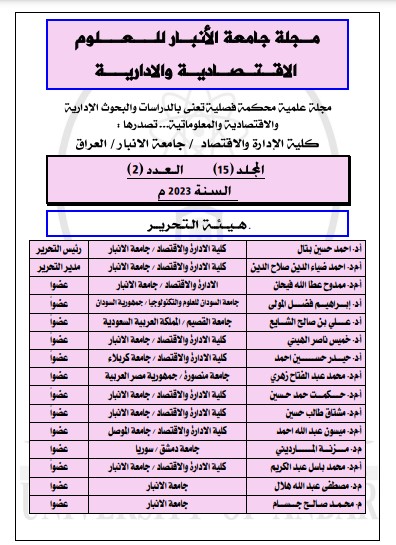نوع المقالة : Research Paper
المؤلف
جامعة الانبار/ كلية الادارة والاقتصاد
الملخص
يهدف البحث الى استكشاف مستوى المرونة في المفاهيم والتطبيقات المحاسبية الحالية المتعلقة بالقياس , من خلال الفحص والتدقيق في المرونة المتوفرة في معايير المحاسبة الدولية (IAS) ومعايير الابلاغ المالي الدولية (IFRS) , وتحديد ما اذا كانت هذه المرونة تمثل عامل قوة أو ضعف للمنتج المحاسبي . لغرض تحقيق هدف البحث تم العمل باتجاهين : الاول , يتركز حول المرونة في اختيار اساس القياس المحاسبي بالاستناد الى عوامل محاسبية وغير محاسبية ( عوامل بيئية ) من قبل الكيان المحاسبي , والثاني يتركز حول طبيعة المعلومات التي يوفرها اساس القياس المعين والقرارات المختلفة التي يخدمها .
استنتج البحث ان المرونة المتأصلة في المفاهيم والتطبيقات المحاسبية المتعلقة بالقياس يمكن ان تعمل على تحسين جودة المعلومات المحاسبية من خلال توفير مستوى عالي من الامانة في العرض , وتجعل المعلومات المحاسبية اكثر قابلية للمقارنة , خاصةً عندما تستثمر تلك المرونة لغرض تحقيق الاهداف الاساسية للمحاسبة , وبالتالي تمثل المرونة عامل قوة . على الجانب الأخر , عندما تستخدم هذه المرونة في تحقيق الاغراض الذاتية للكيان وادارته , سوف تصبح المرونة اداة تستخدم في تشويه المعلومات المحاسبية ولربما المساهمة في تضليل المستخدمين, وبالتالي تمثل المرونة عامل ضعف .
الكلمات الرئيسة
- Ajekwe, Clement C. M. & Ibiamke, Adzor, (2017), Accounting Flexibility and Earnings Management: Evidence From quoted Real Sector Firms in Nigeria, Journal of Research in Business and Management, Volume 5 , Issue 3 ,pp: 01 -08.
- Ajekwe, Clement C.M.,( ), Flexibility in Accounting: A Slippery Slope to Fraud?, https://ssrn.com/abstract=2972726.
- Barth, Mary,(2006), Including estimates of the future in today's financial statements, Bank for International Settlements ,P-3.
- Barth, Mary,(2007), Standard-setting measurement issues and the relevance of research, Accounting and Business Research Special Issue: international Accounting Policy Forum. pp. 7-15.
- Baxter, William,(2003)," The Case for Deprival Value" , Edinburgh: Institute of Chartered Accountants of Scotland, p-17.
- Chambers, R. J. (1966)," Accounting, Evaluation and Economic Behavior" , Englewood Cliffs, NJ: Prentice Hall,p-91.
- Chandra ( Late), J. R., & Azam, M. R. (2019). Principles verses Rules-Based Accounting Standards’ Application in Fiji: An Overview of the Literature. International Journal of Management, Accounting and Economics, 6(1), 88-98.
- Edwards, E. & Pell, P.,(1961),"The Theory and Measurement of Business income " Berkeley, University of California press,p-93.
- Ernst & Young,(2005)," How Fair Is Fair Value?" , London: Ernst & Young.
- FASB,(2010), Conceptual Framework for Financial Reporting: The Objective of General Purpose Financial Reporting, Statement of Financial Accounting Concepts No. 8.
- IASB, (2005)," Measurement Bases for Financial Accounting-Measurement on Initial Recognition", Discussion Paper, Prepare by staff of the Canadian Accounting Standards Board .
- IASB,(2021),IAS8 "Accounting Policies, Changes in Accounting Estimate and Errors ", par-5,32.
- IASB,2018,par4-55.
- IASB,IAS36,(2018),Impairments of assets,par-30
- IASB,IAS36,par-31.
- IASB,IFRS13,(2018),"Fair Value Measurment",par-9.
- IASB,IFRS13,par-76,81,86.
- IASB,op.cit,par4-55.
- IASB,op.cit.,IAS2,par-28.
- IASB,op.cit.,par4-55,D.
- IASB,op.cit.,par4-55.
- ICAEW,(2018),op.cit.,p-21.
- ICAEW,(2018),op.cit.,p-32.
- (2006).Principles not Rules: A question of Judgment. The Institute of ;Chartered Accountants of Scotland, Edinburgh. http://www.icas.org.uk/site/cms/download/rs_ Principles_v_Rules.pdf.
- Jeremy Edwards, John Kay and Colin Mayer,(1987), " The Economic Analysis of Accounting Profitability", Oxford: Clarendon Press,p-126.
- Mulford, C. W. and Comiskey, E. E. (2002). The financial numbers game: Detecting creative accounting practices. New York: John Wiley and Sons Inc.,PP25-26.
- Paton, w. and Littleton, A. C. , (1940), " An Introduction to corporate accounting standard, Florida, AAA, p-14.
- Raubenheimer, Elsje,( 2012),Accounting Estimate in Financial Statements and Their Disclosure by some South African Construction Companies, Journal of Economic and Financial Sciences | JEF| July 2013 6(2), pp. 383-400.
- Revsine, L., (1973), "Replacement Cost Accounting", Englewood Cliffs, NJ : Prentice Hall,p-88.
- Robert R. Sterling, (1970),Theory of the Measurement of Enterprise Income. (Lawrence: University Press of Kansas), p -328.
- Ronen, J. (2008), ‘To fair value or not to fair value: a broader perspective’, ABACUS , 44(2), pp. 181–208.
- Ronen,op.cit.p-186.
- The Institute of Chartered Accountants in England & Wales (2018), " Measurements in financial reporting", p-5.

